#andean culture
Explore tagged Tumblr posts
Text
So apparently Swedish and Polish facial reconstructionists decided to try to recreate the famous Incan "Ice Maiden" mummy dubbed "Juanita".
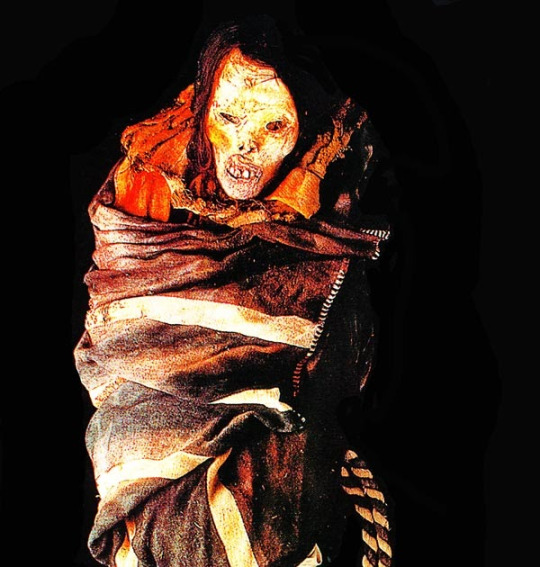

Truthfully, I feel like these European reconstructionists ( do not know how to re-create Andean facial features and the results ended up... terribly uncanny. So down below, with the use of photoshop, I edited the bust with more Andean Indigenous Peruvian facial features to honor the "Ice Maiden".
My version:
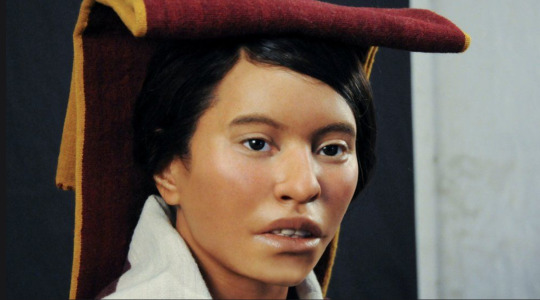
I made her brows straighter and longer, got rid of the cleft chin, gave her a down-turned mouth, broader lips (not small), I made her lips a little larger too and I made her nose longer/bigger and wider around the nasal Ala. I also broadened her nostrils a tad
and I made her under-eyes more puffy
I widened her bone structure
I emphasized her sideburns
My version (on top):
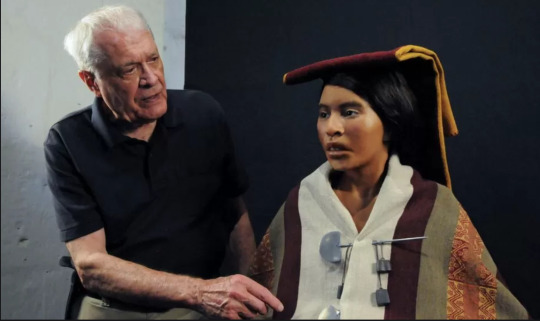
original (white euros created) below:
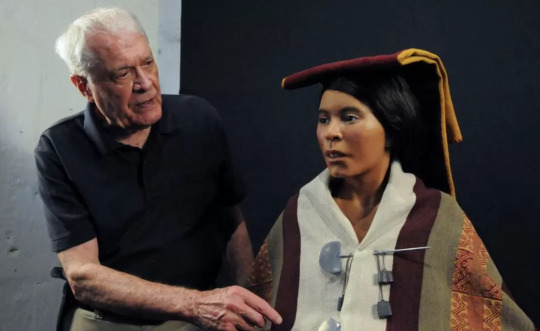
I hope that in the future, more Andean/Indigenous Peruvian facial reconstructionists have opportunities to work on revealing the faces of their kin and ancestors. We needed more andean people involved in her reconstruction.
Let me know what you think of my edits down below too!
I hope you enjoy them!
the original article can be read here:
#I took the artistic liberty to remove her cleft chin all together because i never see andeans like myself with clefts#i love a more down turned lip/mouth shape#archaeology#indigenous peruvians#native peruvian#inca#inca girl#ice maiden#facial reconstruction#my photoshops#andean history#andean pride#native south american#mujer andina#ndn tumblr#andean culture#andean textiles#andean indigenous#indigenous women#andina#andean#bipoc#indigena#pre columbian#andes#warmi#we need more ndns in science
44 notes
·
View notes
Text
This guy made a video about how rainbow-type flags aren't just representative of pride, using the Quechuan flag seen in Andean countries as an example.
instagram
And its pretty neat. I especially like the bit where he explains that it had an extra stripe, a light blue one.
I want all the people that bothered to post comments on the video to be shot


Like, he outright says its a different thing. On top of that, because I had to study this shit, the six-stripe pride flag, the one shown in the video, is not the original in regards to ideation or even conceptualisation. Gilbert Baker wanted pink on the flag, but the thread was hard to come by so he left it out because of money and accessibilty reasons: there was no mention of light blue when I was researching a long while back. That six-stripe flag you see is the one that got shown to the public first, note that Gilbert Baker has nothing to do with any Andean cultures.
Anyway I think its swag as fuck that similar looking flags are getting used by different groups and that this just flat out isn't cultural appropriation and you're a fucking loser if you think that/are using it as a reason to be homophobic.
#Pride#Andean culture#Ecuador#Quechuan#Quechua#Rainbow flag#Gilbert baker#Cultural appropriation#Instagram
11 notes
·
View notes
Text

Andean Painted Stone Tablet c. 3800 – 2200 BP
This gray volcanic stone is painted monochrome red in the Antimpampa style. The prominent motifs are anthropomorphous and zoomorphic figures. The scene centers on abstract three-figured humanoids with alternating inverse animals and other adjacent figures. Formative Period (c. 3800 – 2200 BP).
Measures 21″ in height, 13″ in width, and 1″ in depth. Height on the included stand is 25″. Provenance: Ex. Cathryn Cootner Estate Collection, Sonoma, CA
These adorned stone tablets resemble a collection of later ceramic plaques found at the mountainous Chucu site, Cerro Cupara, Chuquibama, Condesuyos/Arequipa, Peru. They are thought to have served as votive offerings, ensuring the secure journey of the soul to the “Other World.”
#ancient art#ancient history#archaeology#pre-columbian#art history#artifacts#south america#inca#pre-Inca#Andean Culture#stone sculpture
2 notes
·
View notes
Text
Meet the Andean Communities Along the Ausangate Cusco Trek

The Ausangate Cusco trek is not just a journey through breathtaking landscapes but also a cultural immersion into the rich traditions of the Andean communities. As one of the most rewarding trekking routes in Peru, it offers a unique opportunity to interact with local indigenous groups who have preserved their customs for generations. Ausangate Peru takes pride in offering authentic experiences where travelers can connect with the true essence of Andean life while exploring the majestic mountains.
Discover the Local Andean Culture
The remote villages along the Ausangate Cusco trek are home to Quechua-speaking communities that continue to live in harmony with nature. These communities, such as Pacchanta and Upis, are known for their welcoming hospitality, colorful textiles, and traditional ways of life. Herders and weavers in these villages rely on alpacas and llamas for sustenance and craftsmanship, producing some of the finest handwoven garments in Peru.
When trekking with Ausangate Peru, travelers can visit these villages and witness firsthand the traditional weaving techniques that have been passed down for centuries. The intricate patterns and vibrant colors of Andean textiles reflect the spiritual beliefs and daily lives of the people. Purchasing these handmade products directly supports local artisans and helps sustain their ancestral traditions.
Experience Andean Gastronomy and Traditions
One of the highlights of the Ausangate Cusco trek is the chance to enjoy authentic Andean cuisine. Locals often prepare meals using fresh, organic ingredients such as potatoes, quinoa, and corn—staples that have been cultivated in the Andes for thousands of years. Pachamanca, a traditional cooking method where food is baked underground with hot stones, is a must-try experience for those seeking a taste of indigenous culture.
In addition to the culinary delights, visitors can partake in spiritual ceremonies led by local shamans. These rituals, deeply rooted in Incan traditions, often involve offerings to Pachamama (Mother Earth) as a way of expressing gratitude and seeking blessings for a safe journey. Such experiences provide a profound connection to the Andean way of life and the natural world.
Breathtaking Scenery and Local Hospitality
While the towering peaks and turquoise lakes make the Ausangate Cusco trek an unforgettable adventure, the warmth and generosity of the Andean communities leave an equally lasting impression. Trekking with Ausangate Peru ensures a responsible and enriching experience, as the company prioritizes sustainable tourism practices that benefit the local populations.
Many travelers opt for homestays or community-run lodges, where they can share meals with local families and learn more about their daily routines. These interactions foster cultural exchange and provide deeper insight into the resilience and wisdom of the Andean people.
Trek with Purpose
Choosing Ausangate Peru for your trekking adventure means supporting ethical tourism that respects indigenous communities and their environment. Every step along the Ausangate Cusco trail brings not only awe-inspiring landscapes but also meaningful encounters with the people who call these mountains home.
If you’re looking for a trekking experience that goes beyond scenic beauty and delves into the heart of Andean culture, book your journey with Ausangate Peru today. Discover the harmony between nature and tradition on the mesmerizing Ausangate Cusco trek.
#Ausangate Cusco#Andean communities#trekking Peru#Ausangate Peru#Andean culture#Cusco trekking#Ausangate trek#sustainable tourism#Quechua culture
0 notes
Text

Jukumari masker, Bolivia, by maskedtraditions
905 notes
·
View notes
Text
hi hi! this one's mine >u<

What is the first sentence in your WIP?
I’ll go first

23 notes
·
View notes
Text

for @kataang-week -- day 4: cultural exchange
(ID: a digital drawing of katara and aang from atla. they're wearing clothing from each other's cultures. katara is wearing a yellow chuba with red trim, an orange shirt, a chumpi belt, and boots. she has one necklace with small turquoise beads and one with large yellow beads. aang is wearing a parka with a thick fur hood and black-and-white geometric patterns, and dark blue pants. he also has mittens and large boots on. they're smiling at each other, with pink hearts floating between them.
#kataang week#kataang#kataang fanart#artists on tumblr#atla#avatar: the last airbender#cimmeriadraws#the chumpi belt is a traditional andean garment#i assume part of the reason tibet serves as inspo for the air nomads is the high altitude of where they live#and quechua people also live in high altitudes so i think they'd be interesting to pull inspiration from for air nomad clothing#plus atla has already taken inspo from south american cultures with the sun warriors so it works :)#but anyway all i have in this drawing is the chumpi belt so i'd like to incorporate more andean culture into air nomad designs in the futur#i also want to dive some more into siberian and alaskan indigenous clothing for the southern water tribe fashion#and explore ideas for differences between nwt and swt clothing
309 notes
·
View notes
Text
Elongated Skulls

In 1928, elongated skulls were discovered on the Paracas Peninsula, located in the arid Paracas desert along Peru's southern coast.
These intriguing skulls were unearthed by Peruvian archaeologist Julio Tello (1880-1947), who is often referred to as the "Father of Peruvian Archaeology."
This remarkable find consisted of a series of burial sites containing mummified remains with distinctively elongated cranial structures, sparking significant interest and debate in the archaeological and scientific communities.
The skulls, associated with the ancient Paracas culture that thrived from around 800 to 100 BCE, exhibit deliberate cranial elongation — a practice achieved by binding the heads of infants with cloth or wooden boards during early development.
This cultural modification was likely a mark of social status, nobility, or affiliation with a particular group.
The Paracas people's skill in cranial shaping underscores their intricate societal structures and cultural traditions.
What further distinguishes the Paracas burial sites is their remarkable preservation, attributed to the dry desert conditions.
In addition to the elongated skulls, these sites have yielded finely woven textiles, intricate ceramics, and other artifacts that offer invaluable insights into the lives and customs of this ancient civilization.
The elongated skulls remain a subject of fascination and speculation, with some theories — often lacking scientific support — suggesting extraterrestrial or non-human origins.
However, anthropological studies firmly attribute the skulls' shape to intentional cranial deformation, a practice also observed in other ancient cultures worldwide.
Today, the Paracas skulls are housed in museums and continue to be studied by researchers, offering a window into the ingenuity, beliefs, and identity of the Paracas people.
Their discovery by Julio Tello marked a milestone in Peruvian archaeology and remains a cornerstone in our understanding of ancient Andean cultures.
#cranial deformation#elongated skulls#cranial elongation#Paracas Peninsula#Peru#Julio Tello#peruvian archaeology#archaeology#mummified remains#Paracas#ancient civilization#anthropological studies#ancient Andean cultures#ancient history#culture
6 notes
·
View notes
Text
inca method : year begins in january (1400s). year begins in december (1450s).
for deity work : perform a divination ritual on solstices and equinoxes. make an offering beforehand. something only found during those times of the year would be appropriate.


summer solstice : qapaq raymi . december 20-23 (honors apu inti / lord sun)
🩶- passage of time between the two modes +
🌀🌚🥄🤍
WARMI PACHA / feminine time
moons: small crescent moon + great crescent moon + blossom moon + twin cobs moon + corn harvest moon + tilling moon
very close to mushuk wata : 1st of january
fall equinox : pacha puquy raymi . march 20-21 (mushuk nina)
winter solstice : wawa inti raymi . june 20-23 (honors churi inti / daylight)
🩶+ passage of time between the two modes -
💥🌞⚜️🖤
QARI PACHA / masculine time
moons: fallowing moon + sowing moon + lunar feast moon + bird scare moon + ancestral feast moon + great solar feast moon
spring equinox : killa raymi . september 21-24 (honors mama killa / lady moon)
3 notes
·
View notes
Photo


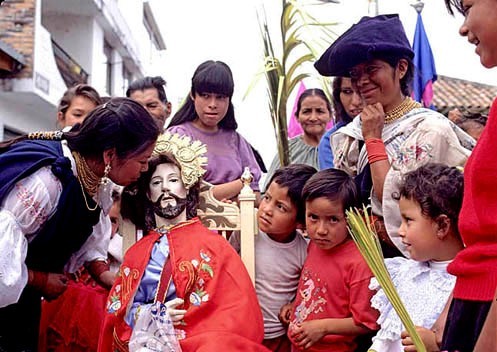

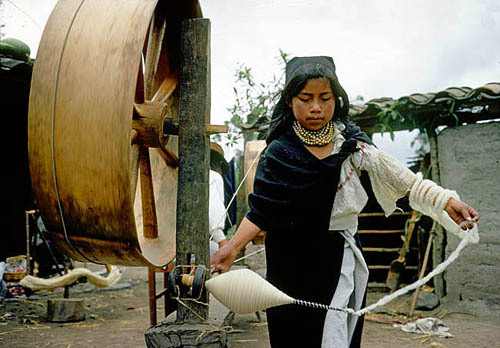
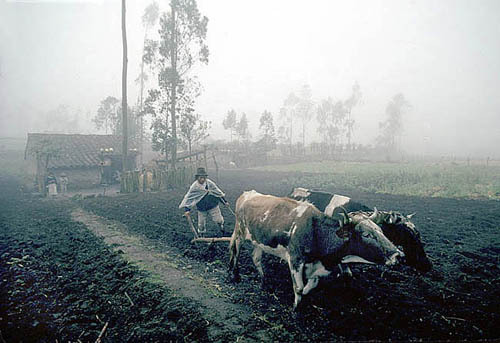


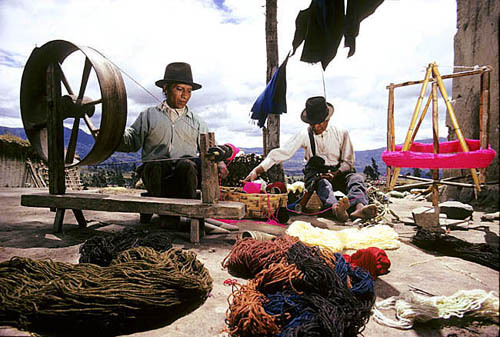

“Scenes from the daily lives of Ecuador’s Indigenous Otavalos” - Victor Englebert
#indigenous#catholicism#indigenous american#native american#folk catholicism#colonialism#andes#ecuador#cultura andina#andean#cultura ecuatoriana#indigenous cultures#south america#native american cultures
50 notes
·
View notes
Note
"Stargazer. Have you a favorite constellation?"
‟A favorite? Oh. That would be a tough choice…”
Izar’s gaze flickers from her unfinished map out of the window; stars of ink, stars of silver, by no means all of them sorted in constellations.
‟Let me think. Some of them hold a special place in my heart because of the stories told about them.”
She steps closer to the window, pointing up. ‟There’s The Two Dragons, both easy to spot even without a telescope. The first one is that group of seven stars just above the mountaintop over there—that line of three is its neck with the head—, and the other one, smaller, is that cluster of five very bright stars closer to the horizon… There. I couldn’t find many depictions of them in the Carian records, but those that exist all show the first dragon as resting, and the other one with open wings, flying towards the horizon.”
She smiles as she leans against the window frame, her gaze never leaving the constellations.
‟Back when the stars moved, both dragons would slowly wander across the night sky, and the smaller one would eventually disappear from view. And it’s said that the first one then cried bitter tears—a shower of silver stars. Or maybe just snow. The records aren’t very clear on this. But I’ve read that in some Churches of Dragon Communion, you might still find a little niche in the northern wall—the one closest to the crying dragon—where people would place tiny dragon figurines as a means of comfort for it. They would often be made of wax and paper, sometimes carved in wood. Burnt as offerings, sending up little dragons to the lonely one in the sky to keep it company.
And eventually… since the stars followed fixed patterns, the small dragon would return to the night sky, and the other one would stop crying. I do believe that maybe that was when spring started. Now that the stars aren’t moving, the small dragon never leaves, so the other one never has to cry. But it would be nicer if they moved, wouldn’t it? The Two Dragons carry a lot of meanings in astrology. Love and grief and hope and fidelity. It all depends on which part of their story you focus on.”
She falls silent for a moment, then points again.
‟Maybe, though, my favorite one is one that the nomadic merchants showed me, because it’s all about hope and… protection? You have to squint a little for this one. Up there, a little above the resting dragon’s head? There’s a spot without stars. But darkness is never just darkness. When the merchants look up to the night sky, they see shapes both in silver and the darkest blue. So that spot of darkness over there, just underneath those two smaller stars?
It’s an outstretched hand, and the stars are a candle sitting in its open palm. That brighter star a little to their right? That’s the candle flame. The merchants believed that this is the hand of a forgotten lord watching over them, and if you ever got lost, you could call out and be guided through the darkness… safely along your path. Unlike the small dragon, the Hand would never disappear from view. You’d always be able to see the candle with its flame. You’d never lose your way in the darkness.
The merchants had a lot of tales and knowledge about the night sky. Most of it is lost. I’m glad this one isn’t.”
#a letter affixed to a graveyard crow's leg | asks#...i might have escalated a bit in my answer but that's just what happens when izar is asked about the stars#thanks for the ask!#it's my headcanon that the constellations and the related tales/meanings would differ between different cultures in the lands between#[i borrowed the idea of spotting constellations in the dark patches of the sky from Andean/Incan cosmology]#asks for izar
3 notes
·
View notes
Text

El Alto, Bolivia
Aerial view of a new boat-shaped cholet. Cholet buildings are part of the neo-Andean architectural style. These constructions are intended to highlight the values and symbols of the Tiwanaku and Inca cultures, which flourished in the Altiplano thousands of years ago, combining them with modern elements of pop culture. They are also a manifestation of the emerging Aymara economic power
Photograph: Aizar Raldes/AFP/Getty Images
#aizar raldes#photographer#afp via getty images#el alta#bolivia#mural#street art#boat-shaped cholet#cholet building#architecture#neo-andean architectural style#tiwanaku and inca cultures#culture#altiplano#aymara economic power
2 notes
·
View notes
Text
Shoutout to the Sudadera Celeste and Big Man Splatoon which singlehandedly feed into my "The Splatlands are LITERALLY Latin America-coded" belief
#dreamy talks#likeeeeee im sorry but the fact that the sudadera celeste has a spanish name even when the game is set in english??#and in the japanese version it has 'セレステ' in the name which is just katakana of Celeste (Light blue in spanish)#LIKEEEEE. same goes for the sudadera roja and the ocho octophones (blancos) but like#what makes me specially insane is that the Sudadera Celeste ALSO has patterns that are very common in south american indigenous cultures#I have noticed the most similarity with Aymara and Mapuche. the sudadera celeste has been driving me insane since the moment#i first saw it bc not only the spanish name but also cuz the patterns. were SO familiar. Like I have seen handmade clothes/tapestries/etc#with those EXACT same patterns it just drives me insane how familiar Splatsville FEELS as a latin american and i love this game sm#cuz of that ngl. It's just nice it kinda makes me feel at home almost?#also im just basically scrapping for crumbs of rep lmfoajfodnfod#I wish the wiki didn't (wrongfully) say that the patterns of the Sudadera Celeste are Inuit-inspired#they resemble native andean textile patterns much more...
7 notes
·
View notes
Text
Galería fotográfica
Retratos familiares

Retrato de Pío Quijada el padre de Sergio Quijada Jara. Foto: Archivo Sergio Quijada Jara. Fines del siglo XIX-inicios del XX (?).
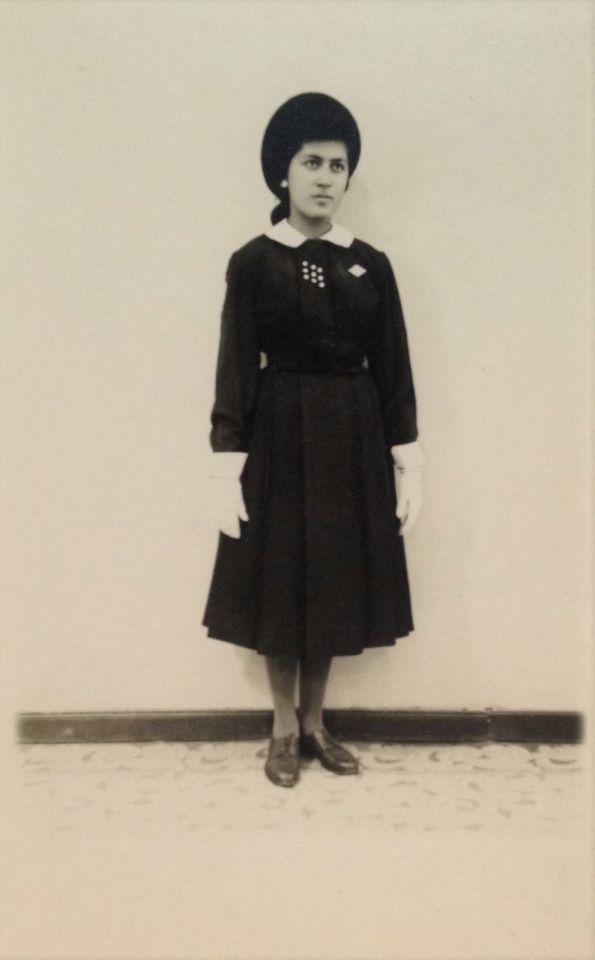
Retrato de Eloisa Quijada Macha. Inscripción manuscrita en el reverso: “Como recuerdo de haber terminado el quinto año de educación secundaria, mi hija Eloísa Quijada, en el Colegio Nacional Nuestra Señora del Rosario de Huancayo. 30 diciembre de 1959”. Foto: Archivo Sergio Quijada Jara. 30 diciembre de 1959. Huancayo.
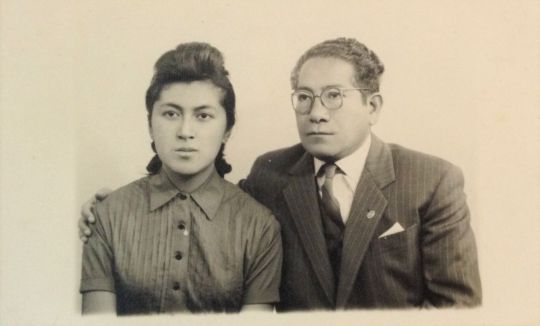
Retrato de Sergio Quijada Jara y su hija Eloisa. Inscripción manuscrita en el reverso: “Para mi hijita Eloísa esta foto para que al contemplar las miradas que van al infinito trate de imitar y superar la categoría intelectual de su padre que alguna vez caerá a la tumba pensando, estudiando y escribiendo acerca de las emociones populares de nuestra patria para hacerla más grande, más unida y más admirada por las demás naciones del mundo. Hyo/ agosto 1960. Sergio”. Foto: Archivo Sergio Quijada Jara. Agosto de 1960. Huancayo.

Retrato de Sergio Quijada Jara y su hija Eloisa. Foto: Archivo Sergio Quijada Jara. Abril de 1976. Tingo María, Huánuco.
#sergio quijada jara#huancayo#huanuco#peru#andes#andean#retrato#fotografia#archivo#archive#sudamerica#south america#patrimonio#patrimonio cultural#cultural heritage#historia#history
5 notes
·
View notes
Text
An absolutely amazing read, I love seeing indigenous women not only surviving but THRIVING👏👏👏🛹🌿
4 notes
·
View notes
Text
honestly though having a solid idea of where everything came from makes any descriptions of food more interesting.
Fuck that post going around saying "you can have coffee in your story without justifying it :) you don't need to explain everything :)" I want, no, I DEMAND a fully researched ethnobotanical paper on every single food item in your work, if you don't explain to me where did potatoes come from in your fantasy setting or don't explain how the industry of coffee works over interstellar distances with full detail you are doing things wrong and I personally hate you and I hate your stupid story, fuck you
#Like you can just#have a fantasy andean culture#maybe theyre trade partners#Or you can actually grapple with colonization and the ways it affects people and the world
93K notes
·
View notes